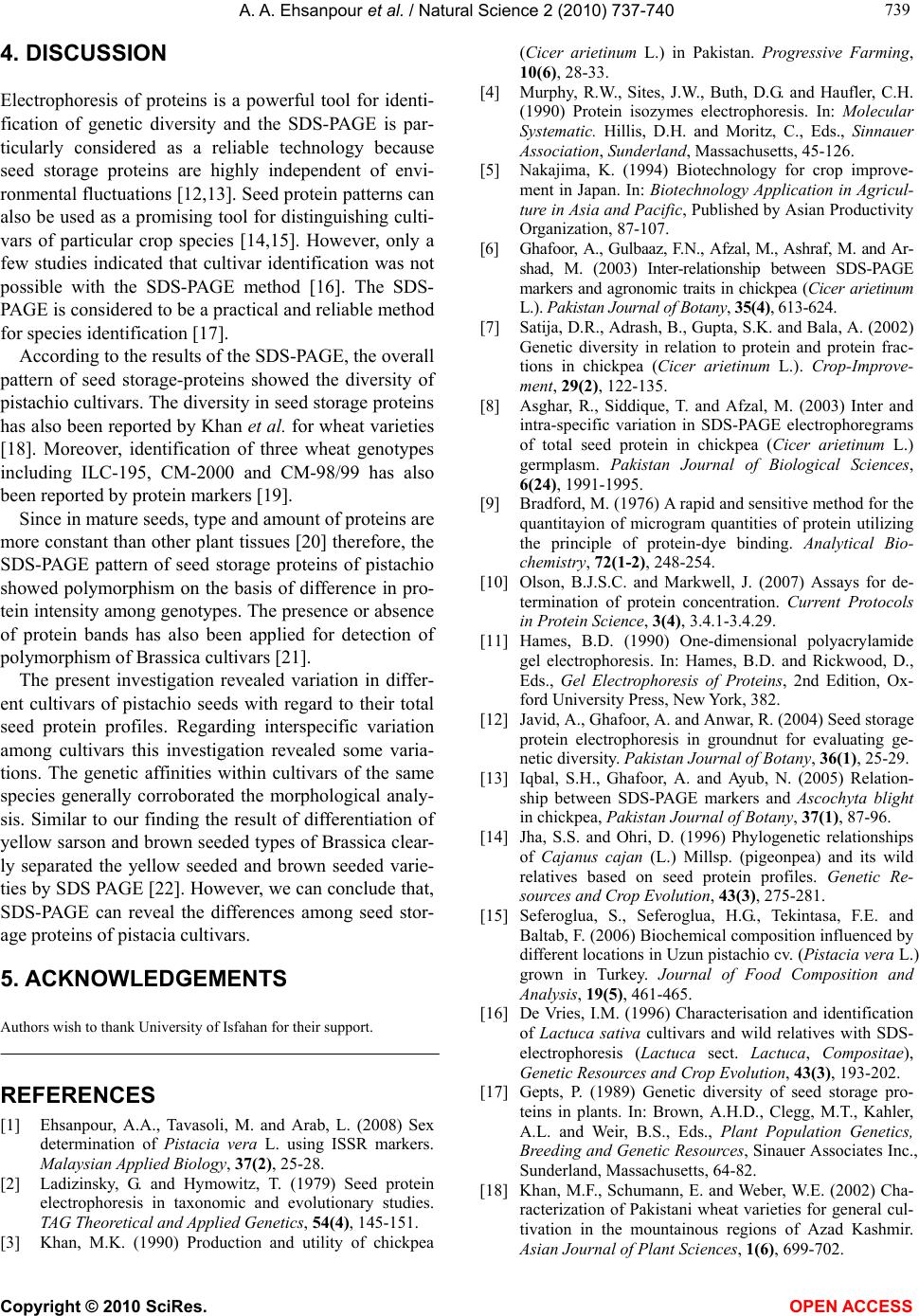
A. A. Ehsanpour et al. / Natural Science 2 (2010) 737-740
Copyright © 2010 SciRes. OPEN ACCESS
739
739
4. DISCUSSION
Electrophoresis of proteins is a powerful tool for identi-
fication of genetic diversity and the SDS-PAGE is par-
ticularly considered as a reliable technology because
seed storage proteins are highly independent of envi-
ronmental fluctuations [12,13]. Seed protein patterns can
also be used as a promising tool for distinguishing culti-
vars of particular crop species [14,15]. However, only a
few studies indicated that cultivar identification was not
possible with the SDS-PAGE method [16]. The SDS-
PAGE is considered to be a practical and reliable method
for species identification [17].
According to the results of the SDS-PAGE, the overall
pattern of seed storage-proteins showed the diversity of
pistachio cultivars. The diversity in seed storage proteins
has also been reported by Khan et al. for wheat varieties
[18]. Moreover, identification of three wheat genotypes
including ILC-195, CM-2000 and CM-98/99 has also
been reported by protein markers [19].
Since in mature seeds, type and amount of proteins are
more constant than other plant tissues [20] therefore, the
SDS-PAGE pattern of seed storage proteins of pistachio
showed polymorphism on the basis of difference in pro-
tein intensity among genotypes. The presence or absence
of protein bands has also been applied for detection of
polymorphism of Brassica cultivars [21].
The present investigation revealed variation in differ-
ent cultivars of pistachio seeds with regard to their total
seed protein profiles. Regarding interspecific variation
among cultivars this investigation revealed some varia-
tions. The genetic affinities within cultivars of the same
species generally corroborated the morphological analy-
sis. Similar to our finding the result of differentiation of
yellow sarson and brown seeded types of Brassica clear-
ly separated the yellow seeded and brown seeded varie-
ties by SDS PAGE [22]. However, we can conclude that,
SDS-PAGE can reveal the differences among seed stor-
age proteins of pistacia cultivars.
5. ACKNOWLEDGEMENTS
Authors wish to thank University of Isfahan for their support.
REFERENCES
[1] Ehsanpour, A.A., Tavasoli, M. and Arab, L. (2008) Sex
determination of Pistacia vera L. using ISSR markers.
Malaysian Applied Biology, 37(2), 25-28.
[2] Ladizinsky, G. and Hymowitz, T. (1979) Seed protein
electrophoresis in taxonomic and evolutionary studies.
TAG Theoretical and Applied Genetics, 54(4), 145-151.
[3] Khan, M.K. (1990) Production and utility of chickpea
(Cicer arietinum L.) in Pakistan. Progressive Farming,
10(6), 28-33.
[4] Murphy, R.W., Sites, J.W., Buth, D.G. and Haufler, C.H.
(1990) Protein isozymes electrophoresis. In: Molecular
Systematic. Hillis, D.H. and Moritz, C., Eds., Sinnauer
Association, Sunderland, Massachusetts, 45-126.
[5] Nakajima, K. (1994) Biotechnology for crop improve-
ment in Japan. In: Biotechnology Application in Agricul-
ture in Asia and Pacific, Published by Asian Productivity
Organization, 87-107.
[6] Ghafoor, A., Gulbaaz, F.N., Afzal, M., Ashraf, M. and Ar-
shad, M. (2003) Inter-relationship between SDS-PAGE
markers and agronomic traits in chickpea (Cicer arietinum
L.). Pakistan Journal of Botany, 35(4), 613-624.
[7] Satija, D.R., Adrash, B., Gupta, S.K. and Bala, A. (2002)
Genetic diversity in relation to protein and protein frac-
tions in chickpea (Cicer arietinum L.). Crop-Improve-
ment, 29(2), 122-135.
[8] Asghar, R., Siddique, T. and Afzal, M. (2003) Inter and
intra-specific variation in SDS-PAGE electrophoregrams
of total seed protein in chickpea (Cicer arietinum L.)
germplasm. Pakistan Journal of Biological Sciences,
6(24), 1991-1995.
[9] Bradford, M. (1976) A rapid and sensitive method for the
quantitayion of microgram quantities of protein utilizing
the principle of protein-dye binding. Analytical Bio-
chemistry, 72(1-2), 248-254.
[10] Olson, B.J.S.C. and Markwell, J. (2007) Assays for de-
termination of protein concentration. Current Protocols
in Protein Science, 3(4), 3.4.1-3.4.29.
[11] Hames, B.D. (1990) One-dimensional polyacrylamide
gel electrophoresis. In: Hames, B.D. and Rickwood, D.,
Eds., Gel Electrophoresis of Proteins, 2nd Edition, Ox-
ford University Press, New York, 382.
[12] Javid, A., Ghafoor, A. and Anwar, R. (2004) Seed storage
protein electrophoresis in groundnut for evaluating ge-
netic diversity. Pakistan Journal of Botany, 36(1), 25-29.
[13] Iqbal, S.H., Ghafoor, A. and Ayub, N. (2005) Relation-
ship between SDS-PAGE markers and Ascochyta blight
in chickpea, Pakistan Journal of Botany, 37(1), 87-96.
[14] Jha, S.S. and Ohri, D. (1996) Phylogenetic relationships
of Cajanus cajan (L.) Millsp. (pigeonpea) and its wild
relatives based on seed protein profiles. Genetic Re-
sources and Crop Evolution, 43(3), 275-281.
[15] Seferoglua, S., Seferoglua, H.G., Tekintasa, F.E. and
Baltab, F. (2006) Biochemical composition influenced by
different locations in Uzun pistachio cv. (Pistacia vera L.)
grown in Turkey. Journal of Food Composition and
Analysis, 19(5), 461-465.
[16] De Vries, I.M. (1996) Characterisation and identification
of Lactuca sativa cultivars and wild relatives with SDS-
electrophoresis (Lactuca sect. Lactuca, Compositae),
Genetic Resources and Crop Evolution, 43(3), 193-202.
[17] Gepts, P. (1989) Genetic diversity of seed storage pro-
teins in plants. In: Brown, A.H.D., Clegg, M.T., Kahler,
A.L. and Weir, B.S., Eds., Plant Population Genetics,
Breeding and Genetic Resources, Sinauer Associates Inc.,
Sunderland, Massachusetts, 64-82.
[18] Khan, M.F., Schumann, E. and Weber, W.E. (2002) Cha-
racterization of Pakistani wheat varieties for general cul-
tivation in the mountainous regions of Azad Kashmir.
Asian Journal of Plant Sciences, 1(6), 699-702.